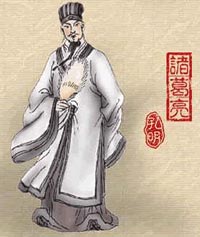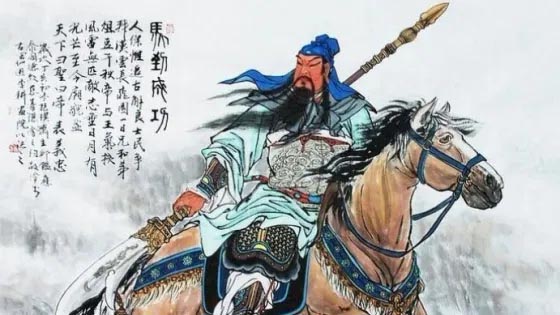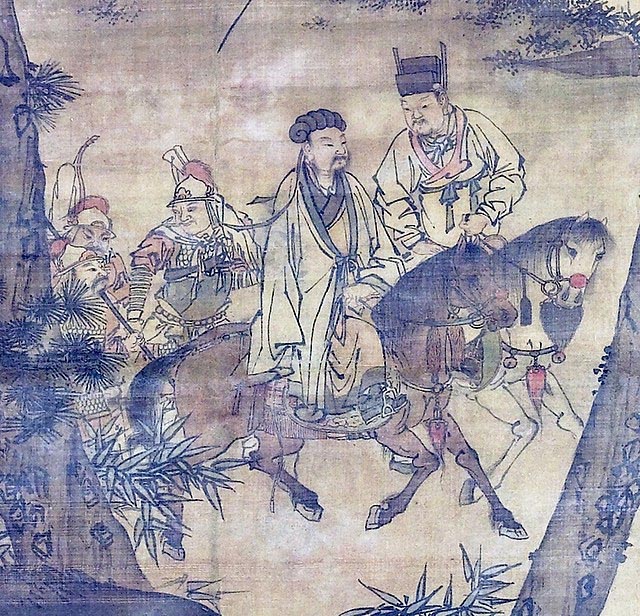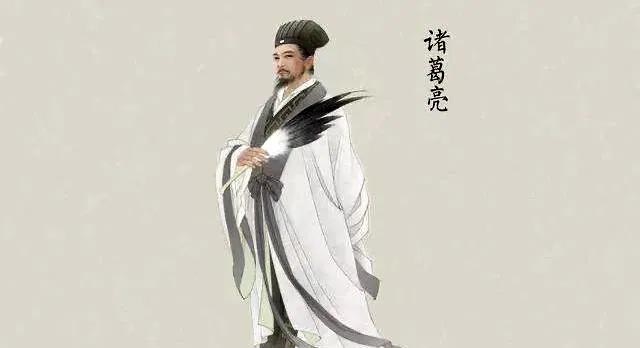The last few years of the Eastern Han Dynasty (25-220) was a period of unbridled fighting among powerful military commanders and widespread political corruption. It was in such turbulent times that Zhuge Liang was born.
Hoping that he would be a bright child, his father gave him the literary name “Kongming,” meaning “intelligent.” A few years later, his parents died successively, and Zhuge Liang, together with his sister and brother, had to depend on his uncle for support.
Unfortunately, however, his uncle also died of illness. Kongming, no more than 17 at that time, began to wander about the country with his sister and brother until they found themselves in a place which is today’s Xiangyang in Hubei province.
They found temporary shelter in the home of Liu Biao, a big landlord who was a friend of their uncle’s.
Faced with the social reality of ceaseless fighting and scrambling for power, Kongming made up his mind to have nothing to do with contemporary politics and live the life of a recluse.In the company of his sister and brother, Kongming came to Longzhong, also in Hubei. They built a few straw huts and what time they could spare from farm work, they spent reading.

Later on, Kongming made the acquaintance of Pang Degong, a learned recluse, and studied under his guidance along with his nephew Pang Tong who soon became Kongming’s intimate friend. Together they discussed current affairs and had free exchanges of their respective aspirations in life.
Pang Degong was extremely gratified with this pair of modest and yet enterprising young men, and never failed to praise them before others for their courtesy and intelligence. He referred to Pang Tong as “Fledgling Phoenix” and Kongming as “Crouching Dragon.”
Kongming made good use of his time and read intensively the works of various ancient philosophers. He studied descriptions of historical events and figures and analyzed social reality, probing into the causes that had led to the decline of the Eastern Han Dynasty.
He was often so immersed in his studies he forgot to eat and rest, reminding himself all the while to become a person useful to society.
Through laboring in the fields and studying, Kongming began to understand the sufferings of the peasants and gained an abundant knowledge of the situation in the world. He had many friends among learned, well-informed men.
With his accumulated experience and growing competence, he developed many original and penetrating views on the contemporary military and political situation.
At that time, Cao Cao was engaged in a war to unify north China, while Sun Quan had established his regime south of the Yangtze River.
The ambitious Liu Bei, a remote descendant of the royal family of the Western Han Dynasty (206 B.C.-24 AD), was planning to expand his sphere of influence so as to restore the Han Dynasty and have the whole China unified under him. But Liu Bei had only two brave generals, Guan Yu and Zhang Fei, to help him. He needed an aide who had brains and a sense of strategy.

Someone recommended to him Zhuge Liang. Greatly delighted, Liu Bei went twice in person with Guan Yu and Zhang Fei to call on Zhuge Liang at his straw hut in Longzhong, but Zhuge Liang deliberately shunned them.
Piqued at this, Guan and Zhang considered Zhuge Liang a haughty person, and tried to dissuade Liu Bei from going again.
But early on the morning of the third day, Liu Bei, braving icy wind and blinding snow, went once again to Longzhong.
When he was told that Zhuge Liang was still in bed, Liu Bei stood patiently outside the door. At last, moved by Liu Bei’s sincerity, Zhuge Liang invited him to come into his hut. Out of this story arose the Chinese proverb “call thrice at the thatched hut,” meaning “to be modest and seek advice in person.”
In his thatched hut, Zhuge Liang discussed freely with Liu Bei the contemporary political and economic situation and recent developments in the war.
The strategies he proposed included immediate occupation of the strategic point of Jingzhou, strengthening internal rule and forging an alliance with Sun Qian in a joint effort to defeat Cao Cao.
All these, Zhuge Liang said, would lead to the unification of the country.

Liu Bei was deeply impressed by Zhuge Liang’s foresight and brilliance, and said to Guan Yu and Zhang Fei with great satisfaction, “With the honorable Zhuge Liang joining my staff, I feel like a fish let into the water.”
After he assumed his post as advisor, Zhuge Liang went in person to Sun Quan and talked him into approving the strategy of forming an alliance with Liu Bei in a common fight against Cao Cao.
In the month of October in 208 A.D., the 50,000 allied troops of Sun Quan and Liu Bei engaged Cao Cao’s mighty army of over 100,000 men at a place named Chibi (the Red Wall). Thanks to Zhuge Liang’s strategems and maneuvers, they won a decisive victory over Cao Cao.
Assisted by Zhuge Liang, Liu Bei established the Kingdom of Shu Han (present-day Sichuan), thus ushering in a new period in Chinese history, that of the Three Kingdoms of Wei, Shu and Wu involved in a three-power rivalry.
Zhuge Liang dedicated his life and energy to the Kingdom of Shu. At the age of 54, he once again led the army of Shu in a battle against Cao Cao and in the end died of overwork and fatigue at the front.
In order to commemorate this outstanding statesman, military strategist and man of letters, the Wuhou Memorial Temple was built in Chengdu in Sichuan province. In China, Zhuge Liang has always been regarded as the embodiment of intelligence and wisdom. — First published in Tulay Fortnightly, Chinese-Filipino Digest 28, no. 3 (July 7-20, 2015): 13.
